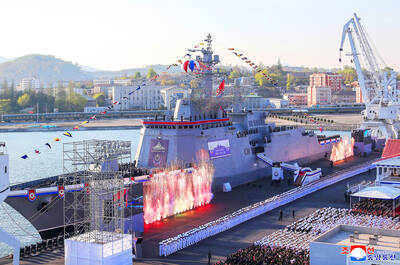A round of UN climate talks was wrapping up on Friday, helped by a dose of trust after the Copenhagen Summit, but still troubled by the splits which drove that historic conference close to disaster.
After 12 days of talks, delegates were issued with a gingerly worded document which seeks to revive the quest toward a post-2012 treaty after the rows in Copenhagen last December.
If approved, the draft text would become an official blueprint for negotiations.
And in turn, if all goes well, that would culminate in a deal — possibly by the end of next year — which would slash emissions of greenhouse gases and channel billions of dollars in aid to poor countries in climate change’s firing line.
After Copenhagen, where bickering and nit-picking brought the world’s biggest summit close to a breakdown, the mood in Bonn showed a good improvement, delegates said.
“Many of the issues, especially the issues that are important to developing countries, are being discussed in a more effective and constructive way,” said Yvo de Boer, making his swan song as the UN Framework Convention on Climate Change’s (UNFCCC) executive secretary.
“This all in all is a big step forward, making much more possible in Cancun,” he said.
The talks were the mid-way point to the next big UNFCCC gathering, taking place in the Mexican resort of Cancun from Nov. 29 to Dec. 10.
But beneath the brighter tone, problems of substance remained.
Major blocs set down early markers of their opposition to the tentative text, drafted by Margaret Mukahanana-Sangarwe of Zimbabwe, who chairs the main negotiating group.
The document puts forward a range of goals for cutting greenhouse gases, including slashing emissions by as much as 85 percent by 2050 compared with 1990 levels, and sketches objectives for climate aid and deforestation.
Debate is likely to be furious at the next round of talks in Bonn in August over how to share out the burden and where to place priorities. In addition, the text still has big gaps, including the legal status of the post-2012 treaty.
The so-called G-77 bloc of developing countries and, separately, the associations of African states, small island states and least-developed states, warned that they considered the text to have many gaps, weighed in favor of rich economies or even violating the principles of the UNFCCC.
They were especially worried it meant the death knell of the Kyoto Protocol, the world’s sole treaty that spells out targeted reductions in carbon emissions. Kyoto’s commitments expire at the end of 2012.
China’s delegate Su Wei (蘇偉) poured criticism on Mukahanana-Sangarwe’s efforts.
“I was very much surprised,” said Su. Referring to a 2007 initiative that charted the way towards the envisioned treaty, he charged: “You deviated from the Bali Road Map by 50 percent.”
Others were less harsh.
“We’ve got problems with it [the text] as everyone has, but we are prepared to move forward on it as a basis for discussion ... at least we’ve got a starting point,” South African delegate Alf Wills said.
The US was non-committal, saying it would closely study the text.
“Everyone will find something they like, as well as something they hate,” Kaisa Kosonen of Greenpeace said.
Alden Meyer of the Union of Concerned Scientists warned that the clock was ticking.
“With only two weeks of negotiating time now left before Cancun, it is vital that countries move beyond procrastination and start engaging in direct negotiations on these big issues when they return in August,” Meyer said.
Man-made greenhouse gases are a by-product of burning oil, gas and coal, which provides the backbone of today’s energy supply, and from deforestation.
Colorless and odorless, these gases are accumulating in the lower atmosphere, trapping heat from the Sun in the famous “greenhouse” effect.
On current trends, warming from the sun will so disrupt Earth’s fragile climate system that many millions of people will face worse droughts, floods, storms and rising seas levels by the end of the century, the UN’s climate panel says.

Archeologists in Peru on Thursday said they found the 5,000-year-old remains of a noblewoman at the sacred city of Caral, revealing the important role played by women in the oldest center of civilization in the Americas. “What has been discovered corresponds to a woman who apparently had elevated status, an elite woman,” archeologist David Palomino said. The mummy was found in Aspero, a sacred site within the city of Caral that was a garbage dump for more than 30 years until becoming an archeological site in the 1990s. Palomino said the carefully preserved remains, dating to 3,000BC, contained skin, part of the

TRUMP EFFECT: The win capped one of the most dramatic turnarounds in Canadian political history after the Conservatives had led the Liberals by more than 20 points Canadian Prime Minister Mark Carney yesterday pledged to win US President Donald Trump’s trade war after winning Canada’s election and leading his Liberal Party to another term in power. Following a campaign dominated by Trump’s tariffs and annexation threats, Carney promised to chart “a new path forward” in a world “fundamentally changed” by a US that is newly hostile to free trade. “We are over the shock of the American betrayal, but we should never forget the lessons,” said Carney, who led the central banks of Canada and the UK before entering politics earlier this year. “We will win this trade war and

‘BODIES EVERYWHERE’: The incident occurred at a Filipino festival celebrating an anti-colonial leader, with the driver described as a ‘lone suspect’ known to police Canadian police arrested a man on Saturday after a car plowed into a street party in the western Canadian city of Vancouver, killing a number of people. Authorities said the incident happened shortly after 8pm in Vancouver’s Sunset on Fraser neighborhood as members of the Filipino community gathered to celebrate Lapu Lapu Day. The festival, which commemorates a Filipino anti-colonial leader from the 16th century, falls this year on the weekend before Canada’s election. A 30-year-old local man was arrested at the scene, Vancouver police wrote on X. The driver was a “lone suspect” known to police, a police spokesperson told journalists at the

North Korean leader Kim Jong-un has unveiled a new naval destroyer, claiming it as a significant advancement toward his goal of expanding the operational range and preemptive strike capabilities of his nuclear-armed military, state media said yesterday. North Korea’s state-run Korean Central News Agency (KCNA) said Kim attended the launching ceremony for the 5,000-tonne warship on Friday at the western port of Nampo. Kim framed the arms buildup as a response to perceived threats from the US and its allies in Asia, who have been expanding joint military exercises amid rising tensions over the North’s nuclear program. He added that the acquisition